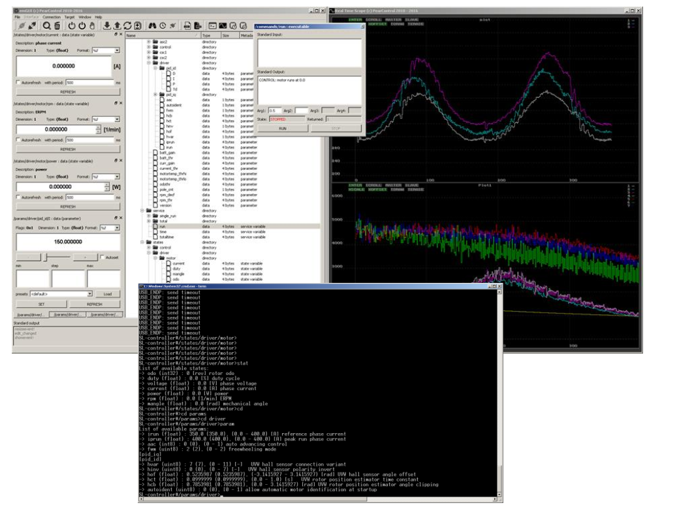SWTools
is an essential, modular set of software tools for manipulating siliXcon devices and integrating them into your application.
The single software package is compatible with all our devices.
Who is this software for:
- System integrators (those who integrate siliXcon devices into a product)
- Solution developers (those who are designing a product from ground-up with siliXcon platform)
- Researchers (motor developers, control algorithm evaluators)
- Enthusiasts (anyone with R&D spirit and curiosity-driven mindset)
- SiliXcon staff
Who is this software not for:
- End users
Example of a typical hardware setup:
Examples of what can you do with SWTools and a siliXcon device:
- Set up a communication interface to establish a connection
- configure parameters
- observe state variables
- execute commands and see results
- read logs and permanents
- perform verbose diagnostics
- save and load configuration to/from a file
- write and run scripts
- measure system performance
- View and log real-time process data
- write a custom End-of-Line configurator for your product
- create a GUI for your application
- upgrade or downgrade the firmware
- identify system parameters automatically
- connect to multiple devices simultaneously
- tune your application in-the-loop
- perform independent feature evaluation of your product
- make a remote session with siliXcon CC support
- ... and much more ...

Service protocol
The tools utilize a proprietary service protocol to interact with the device. This protocol has been designed for low-latency, connection-less reliable data probing, configuring and upgrading in-application. It comprises a series of processes operating within the device, which are by default connected to all communication interfaces. However, these can be deactivated or substituted on specific interfaces upon request. This suite of services enables users to adjust settings, perform debugging, or update the firmware. The service protocol operates independently of the interface, allowing it to be connected to multiple communication interfaces at the same time. It does not depend on any item description files or object definitions. Instead, the device-specific data model is dynamically loaded from the device during runtime.
The following services run inside the YOS device (as a part of the service protocol):
- PWR (power) controls the device's power state. It can power on, power off or restart the device. It also controls debugging output. It is used by term, emGUI, yosctl and bl_srm.
- FWD (forward) forwards messages from one interface to another. It allows communication between devices that are not directly connected. Used by the msg_fwd interface driver.
- ID (identification) transfers device metadata (HWID, SWID, UUID ...). Used by auth, emGUI, yosctl and bl_srm.
- BL (bootloader) reads, erases, writes and configures firmware, used by bl_srm.
- FS (filesystem) filesystem transfer, used by emGUI and yosctl.
- RPC (remote procedure call) executing commands in the device, used by emGUI and yosctl.
- STREAM (ASCII environment) default standard input/output streaming, used by term.
- PLOT (real-time data sampling) data transfer for real-time viewing and logging state variables, used by the scope.